SUBARU OUTBACK 2005 4.G User Guide
Manufacturer: SUBARU, Model Year: 2005, Model line: OUTBACK, Model: SUBARU OUTBACK 2005 4.GPages: 627, PDF Size: 6.42 MB
Page 11 of 627
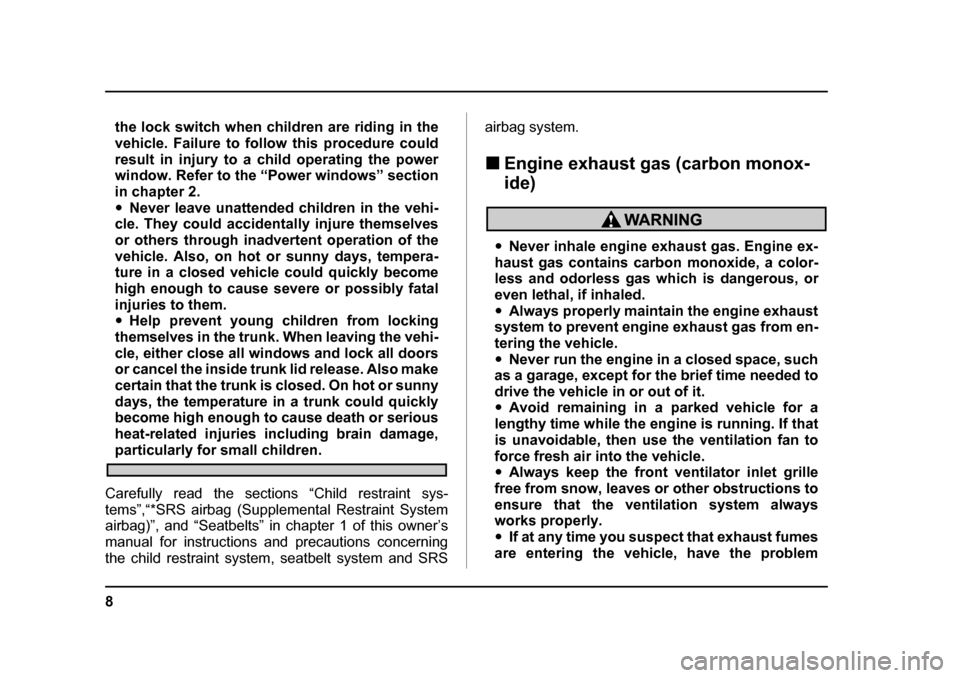
8
the lock switch when children are riding in the
vehicle. Failure to follow this procedure could
result in injury to a child operating the power
window. Refer to the “Power windows” section
in chapter 2."Never leave unattended children in the vehi-
cle. They could accidentally injure themselves
or others through inadvertent operation of the
vehicle. Also, on hot or sunny days, tempera-
ture in a closed vehicle could quickly become
high enough to cause severe or possibly fatal
injuries to them. " Help prevent young children from locking
themselves in the trunk. When leaving the vehi-
cle, either close all windows and lock all doors
or cancel the inside trunk lid release. Also make
certain that the trunk is closed. On hot or sunny
days, the temperature in a trunk could quickly
become high enough to cause death or serious
heat-related injuries including brain damage,
particularly for small children.
Carefully read the sections “Child restraint sys-
tems”,“*SRS airbag (Supplemental Restraint System
airbag)”, and “Seatbelts” in chapter 1 of this owner’s
manual for instructions and precautions concerning
the child restraint system, seatbelt system and SRS airbag system. !
Engine exhaust gas (carbon monox- ide)
"Never inhale engine exhaust gas. Engine ex-
haust gas contains carbon monoxide, a color-
less and odorless gas which is dangerous, or
even lethal, if inhaled. " Always properly maintain the engine exhaust
system to prevent engine exhaust gas from en-
tering the vehicle. " Never run the engine in a closed space, such
as a garage, except for the brief time needed to
drive the vehicle in or out of it. " Avoid remaining in a parked vehicle for a
lengthy time while the engine is running. If that
is unavoidable, then use the ventilation fan to
force fresh air into the vehicle. " Always keep the front ventilator inlet grille
free from snow, leaves or other obstructions to
ensure that the ventilation system always
works properly. " If at any time you suspect that exhaust fumes
are entering the vehicle, have the problem
Page 12 of 627
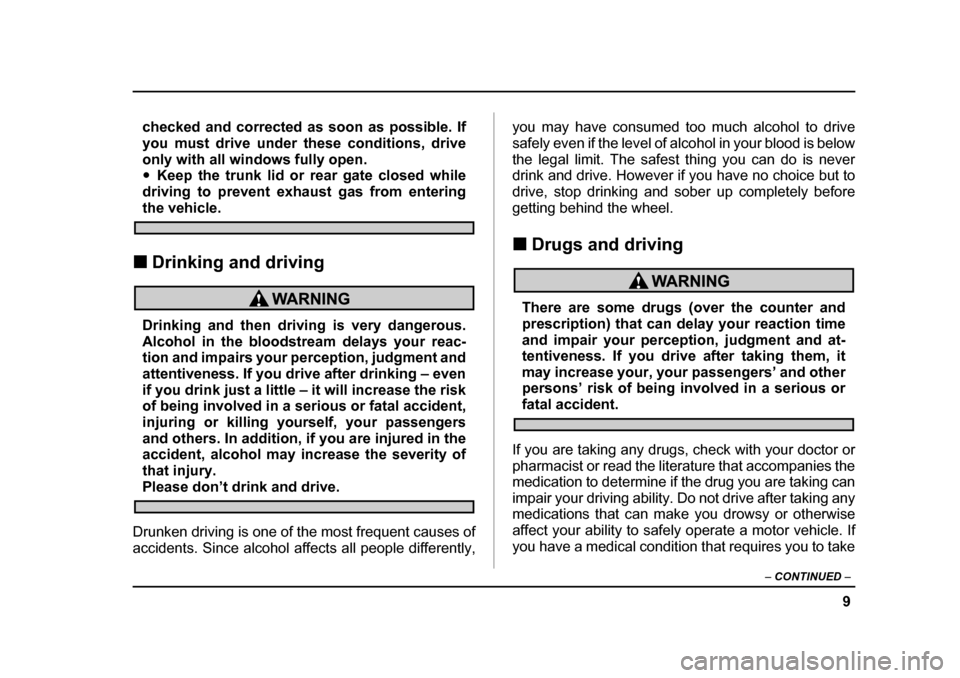
9
–
CONTINUED –
checked and corrected as soon as possible. If
you must drive under these conditions, drive
only with all windows fully open. "Keep the trunk lid or rear gate closed while
driving to prevent exhaust gas from entering
the vehicle.
! Drinking and driving
Drinking and then driving is very dangerous.
Alcohol in the bloodstream delays your reac-
tion and impairs your perception, judgment and
attentiveness. If you drive after drinking – even
if you drink just a little – it will increase the risk
of being involved in a serious or fatal accident,
injuring or killing yourself, your passengers
and others. In addition, if you are injured in the
accident, alcohol may increase the severity of
that injury.
Please don’t drink and drive.
Drunken driving is one of the most frequent causes of
accidents. Since alcohol affects all people differently, you may have consumed too much alcohol to drive
safely even if the level of alcohol in your blood is below
the legal limit. The safest thing you can do is never
drink and drive. However if you have no choice but to
drive, stop drinking and sober up completely before
getting behind the wheel. !
Drugs and driving
There are some drugs (over the counter and
prescription) that can delay your reaction time
and impair your perception, judgment and at-
tentiveness. If you drive after taking them, it
may increase your, your passengers’ and other
persons’ risk of being involved in a serious or
fatal accident.
If you are taking any drugs, check with your doctor or
pharmacist or read the literature that accompanies the
medication to determine if the drug you are taking can
impair your driving ability. Do not drive after taking any
medications that can make you drowsy or otherwise
affect your ability to safely operate a motor vehicle. If
you have a medical condition that requires you to take
Page 13 of 627
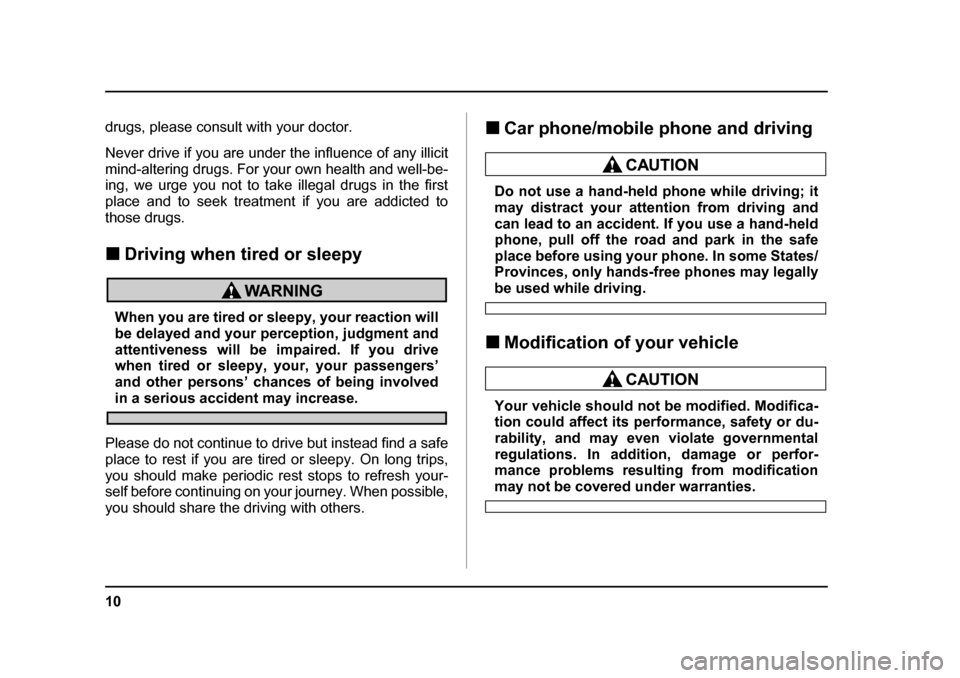
10
drugs, please consult with your doctor.
Never drive if you are under the influence of any illicit
mind-altering drugs. For your own health and well-be-
ing, we urge you not to take illegal drugs in the first
place and to seek treatment if you are addicted to
those drugs. !Driving when tired or sleepy
When you are tired or sleepy, your reaction will
be delayed and your perception, judgment and
attentiveness will be impaired. If you drive
when tired or sleepy, your, your passengers’
and other persons’ chances of being involved
in a serious accident may increase.
Please do not continue to drive but instead find a safe
place to rest if you are tired or sleepy. On long trips,
you should make periodic rest stops to refresh your-
self before continuing on your journey. When possible,
you should share the driving with others. !
Car phone/mobile phone and driving
Do not use a hand-held phone while driving; it
may distract your attention from driving and
can lead to an accident. If you use a hand-held
phone, pull off the road and park in the safe
place before using your phone. In some States/
Provinces, only hands-free phones may legally
be used while driving.
! Modification of your vehicle
Your vehicle should not be modified. Modifica-
tion could affect its performance, safety or du-
rability, and may even violate governmental
regulations. In addition, damage or perfor-
mance problems resulting from modification
may not be covered under warranties.
Page 14 of 627
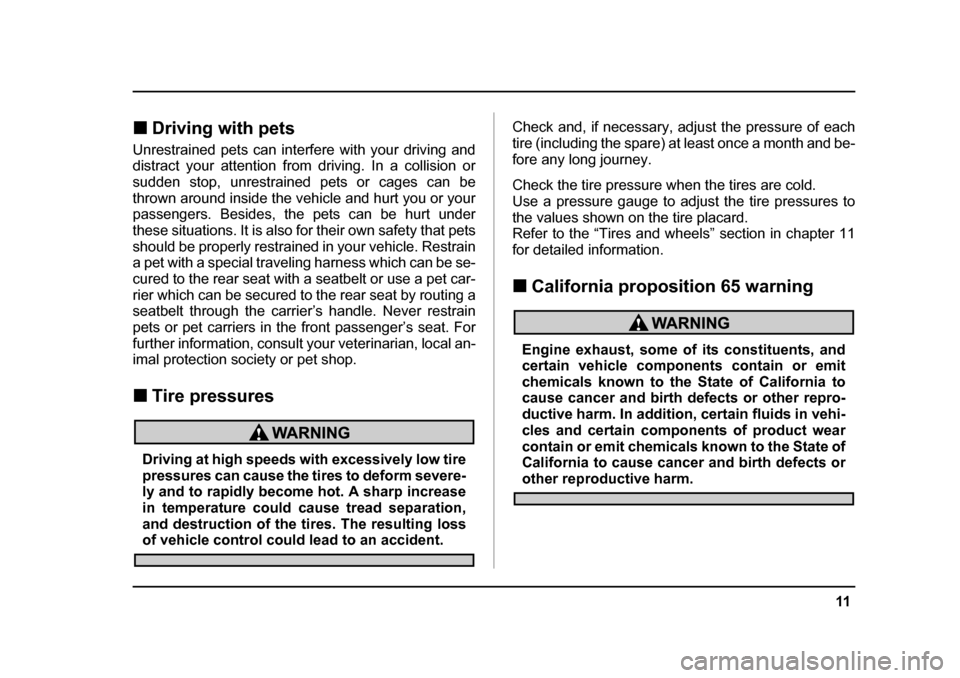
11
–
CONTINUED –
!Driving with pets
Unrestrained pets can interfere with your driving and
distract your attention from driving. In a collision or
sudden stop, unrestrained pets or cages can be
thrown around inside the vehicle and hurt you or your
passengers. Besides, the pets can be hurt under
these situations. It is also for their own safety that pets
should be properly restrained in your vehicle. Restrain
a pet with a special traveling harness which can be se-
cured to the rear seat with a seatbelt or use a pet car-
rier which can be secured to the rear seat by routing a
seatbelt through the carrier’s handle. Never restrain
pets or pet carriers in the front passenger’s seat. For
further information, consult your veterinarian, local an-
imal protection society or pet shop. ! Tire pressures
Driving at high speeds with excessively low tire
pressures can cause the tires to deform severe-
ly and to rapidly become hot. A sharp increase
in temperature could cause tread separation,
and destruction of the tires. The resulting loss
of vehicle control could lead to an accident. Check and, if necessary, adjust the pressure of each
tire (including the spare) at least once a month and be-
fore any long journey.
Check the tire pressure when the tires are cold.
Use a pressure gauge to adjust the tire pressures to
the values shown on the tire placard.
Refer to the “Tires and wheels” section in chapter 11
for detailed information. !
California proposition 65 warning
Engine exhaust, some of its constituents, and
certain vehicle components contain or emit
chemicals known to the State of California to
cause cancer and birth defects or other repro-
ductive harm. In addition, certain fluids in vehi-
cles and certain components of product wear
contain or emit chemicals known to the State of
California to cause cancer and birth defects or
other reproductive harm.
Page 15 of 627

Page 16 of 627

14
9
12
8
1
2
3
4
5
6
7
13
10
11
Table of contentsSeat, seatbelt and SRS airbags
Keys and doors
Instruments and controls
Climate control Audio
Interior equipment
Starting and operating
Driving tips
In case of emergency
Appearance care
Maintenance and service
Specifications
Consumer information and Reporting safety defects
Index
Page 17 of 627
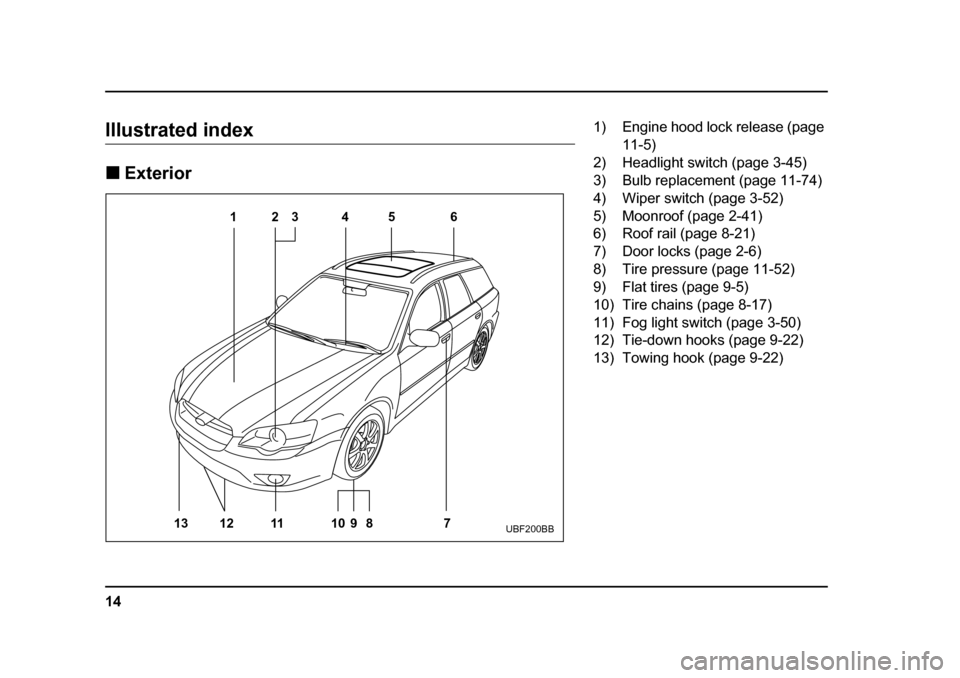
14
Illustrated index !Exterior
123 5 6 4
13 11 12 89 10 7
UBF200BB
1) Engine hood lock release (page
11-5)
2) Headlight switch (page 3-45)
3) Bulb replacement (page 11-74)
4) Wiper switch (page 3-52)
5) Moonroof (page 2-41)
6) Roof rail (page 8-21)
7) Door locks (page 2-6)
8) Tire pressure (page 11-52)
9) Flat tires (page 9-5)
10) Tire chains (page 8-17)
11) Fog light switch (page 3-50)
12) Tie-down hooks (page 9-22)
13) Towing hook (page 9-22)
Page 18 of 627
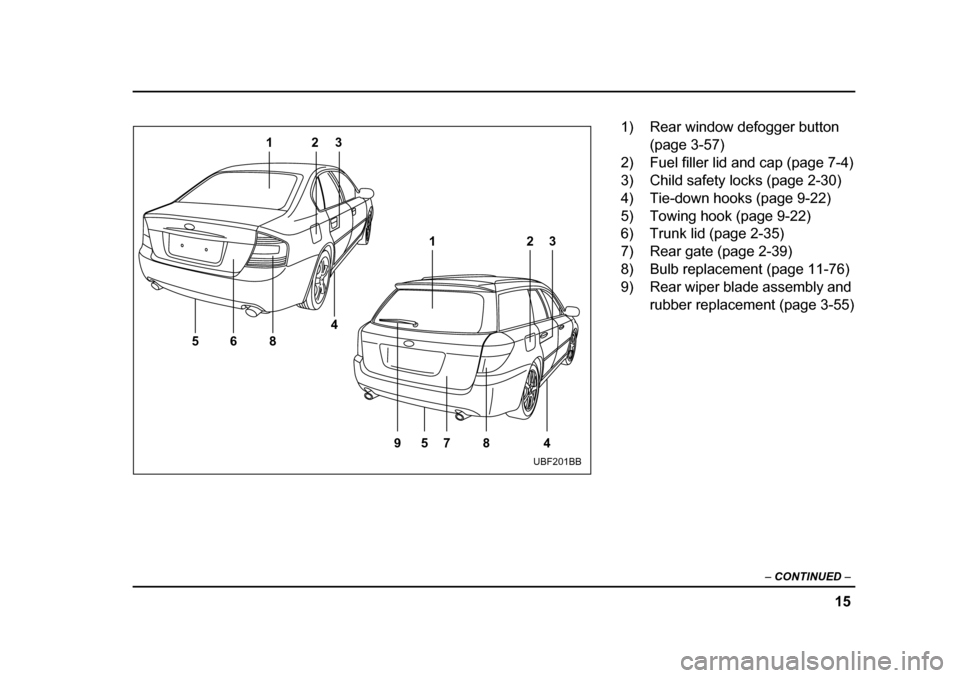
15
–
CONTINUED –
68
5 4
123
7
5
98 4
12
3
UBF201BB
1) Rear window defogger button
(page 3-57)
2) Fuel filler lid and cap (page 7-4)
3) Child safety locks (page 2-30)
4) Tie-down hooks (page 9-22)
5) Towing hook (page 9-22)
6) Trunk lid (page 2-35)
7) Rear gate (page 2-39)
8) Bulb replacement (page 11-76)
9) Rear wiper blade assembly and
rubber replacement (page 3-55)
Page 19 of 627
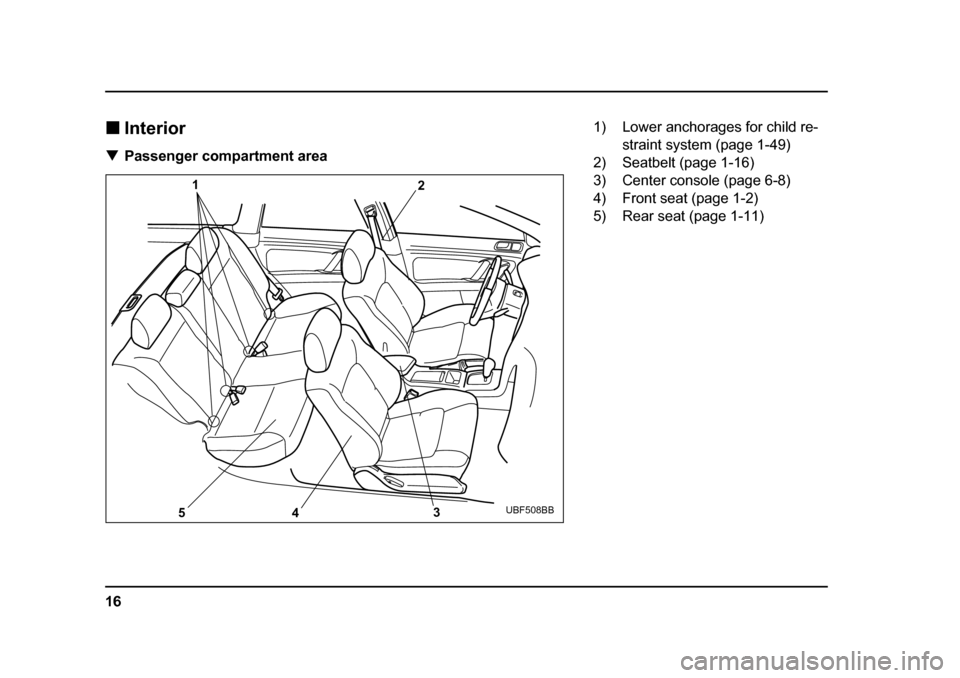
16
!
Interior
! Passenger compartment area
1
2
4
5
3UBF508BB
1) Lower anchorages for child re-
straint system (page 1-49)
2) Seatbelt (page 1-16)
3) Center console (page 6-8)
4) Front seat (page 1-2)
5) Rear seat (page 1-11)
Page 20 of 627
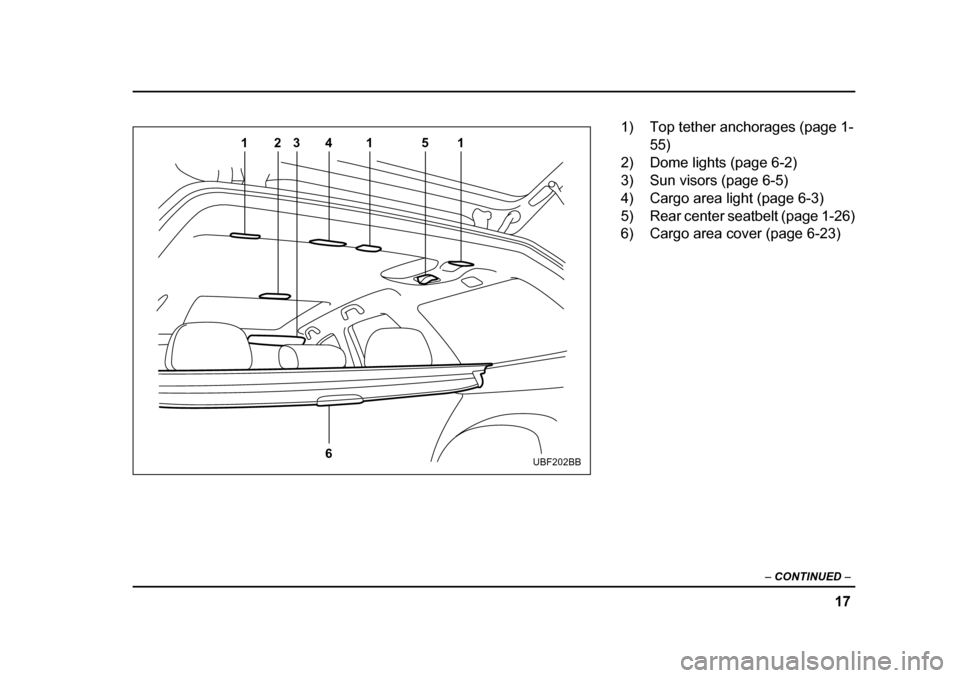
17
–
CONTINUED –
12 4
6
315
1
UBF202BB
1) Top tether anchorages (page 1-
55)
2) Dome lights (page 6-2)
3) Sun visors (page 6-5)
4) Cargo area light (page 6-3)
5) Rear center seatbelt (page 1-26)
6) Cargo area cover (page 6-23)